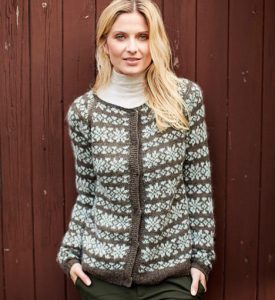A women's cardigan with a jacquard pattern is quite difficult to knit, but the results are definitely worth the effort: the opportunity to knit a unique item with an interesting pattern into your wardrobe. For those who have not worked with a jacquard pattern before, it is recommended to start with geometric patterns - it will be easier to see symmetry in them.
In order to knit a classic cardigan, you need to knit in the round, then make a cut along the front line and knit the strips.

The jacquard pattern has long runs, and it works best if it matches on the body and sleeves. To make it easier to achieve this result, it is recommended to knit the sleeves first - this way you can make adjustments when knitting the body later.
Yarn selection
You will need at least two colors of yarn. To create a jacquard pattern, you can choose any type of yarn, but it is important to consider:
- They must be of the same quality and thickness.
- It is worth giving preference to yarn with well-fixed dye.
- A non-slip and elastic material, such as natural wool, is best.
Scheme and pattern
Scheme A – back, B – shelves, C – sleeves. In each pattern, 1 square equals 1 loop and 1 row.
The formation of the pattern occurs on both the front and back sides of the product, because all odd rows are front, all even rows are back.
On the back of the cardigan, the pattern will be poorly visible, so it is important not to deviate from the pattern.
Before you start knitting a product, it is advisable to knit a small “sample” to get used to the pattern.
Step-by-step description of knitting
When making a jacquard pattern, it is important to consider that the non-working thread remains on the wrong side, forming a broach. So you need to knit no more than 4-5 loops without changing the color or securing the threads.
The jacquard pattern is knitted using stockinette stitch according to patterns A-C. For each part, loops are made 1 time wide between arrows a and b and the number of rows indicated in the diagram.
Back
Knitted using counted pattern A, full width. Decrease on both sides (7 points each, then special decreases 8 points each). After the last row of the pattern, knit in stockinette stitch and bind off 3 stitches on both sides for the armhole.
Shelves (left, right performed symmetrically)

Cast on 58 stitches, knit according to the full width pattern. Then remove 6 sts from the right. Inside, make special decreases of 8 sts. After the last row, knit with knit stitches, make an armhole as for the back. On the 26th row, close the armholes on the left to cut the neckline. On the right is a bevel of the shoulder, as on the back.
Sleeves
They can be started as a first step for more accurate symmetry. Cast on 55 stitches, knit according to pattern C, full width.
For bevels, decrease by 2p on both sides. (51 p. after 52 rows). After the last row of the counted pattern, knit in stockinette stitch. From the cast-on edge to the hem on both sides, close 3 stitches. In every second row. Then cast off the remaining 15 stitches.
Assembly
In this version, when assembling, the edges are tied and two hooks are sewn on top (button strips are not crocheted).
First, 74 loops are cast on along the vertical edges of the shelves. The edging is knitted according to the pattern (1 purl row with purl stitches, 1 knit row with knit stitches, 1 purl row with knit stitches) at the same time closing the loops.
For a double collar, cast on 72 stitches and knit in stockinette stitch.
Fold the collar in half, bending it inward. Then hem from the wrong side and sew from the end sides. The sleeves are sewn in, then the side seams and sleeve seams are made and hooks are sewn on (the first at the beginning, the second 8 cm below).


 0
0





